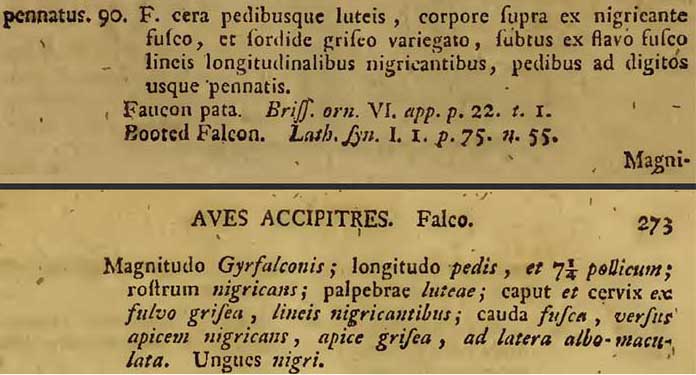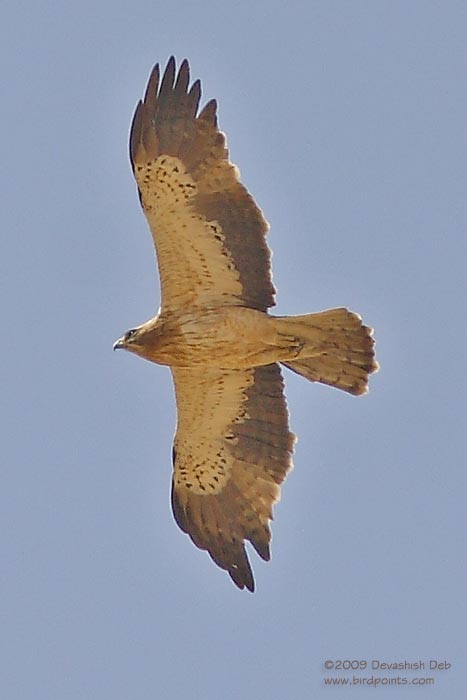|
|
| Booted Eagle |
Hieraaetus pennatus
|
| 23 December 2009 |
| Full Species (monotypic);
i.e. no subspecies/races Hieraaetus pennatus; Gmelin, JF, 1788; Systema Naturae 1, p272  |
|
|
|
Historical
Pls use the mousewheel to zoom in/out (Max 2X)
 Jaisalmer outskirts, Rajasthan, India 02 March 2009 A single bird was seen circling in the sky 1208. Hieraetus pennatus. The Booted Eagle. Falco pennatus, Gmel Syst. Nat. i, p. 272 (1788). Spizaetus milvoides, Jerdon, Madr. Jour. L, S. x, p. 75 (1839). Hieraetus pennatus, Blyth, Cat. p. 28; id. Ibis, 1866, p. 241; Hume, Rough Notes, p. 182; Hume & Dav. S. F. vi, p. 11; Davidson & Wend. S. F. vii, p. 74; Hume, ibid. p. 198; id. Cat. no. 31; id. S. F. x, p. 335; xi, p. 9; Vidal, S. F. ix, p. 30; Butler, S. F. ix, p. 372; Swinhoe, Ibis, 1882, p. 99; Davidson, S. F. x, p. 287; Reid, ibid. p. 450; Barnes, Birds Bom. p. 30. Aquila pennata, Layard, AMNH (2) xii, p 98; Horsf & M. Cat. i, p. 43; Jerdon, B. I. i, p. 63; id. Ibis, 1871, p. 246; A. Anderson, P. Z. S. 1872, p. 74; 1875, p. 24; Hume, S. F. iii, p. 387; Butler, S. F. vii, p. 174; St. John, Ibis, 1889, p. 152. Nisaetus pennatus, Sharpe, Cat. B. M. i, p. 253; Hume, S. F. iii, p. 25; Gurney, Ibis, 1877, p.419; legge, Birds Ceyl. p. 40; Biddulph, Ibis, 1881, p. 41; Scully, ibid. p. 420; Oates, B. B. ii, p. 189; id. in Humes N.& E. 2nd ed. iii, p. 144. The Dwarf Eagle, Jerdon; Bayhati Jumiz, Gilheri Mar, H.; Udatal Gedda, T.; Punja prandu, Tam.; Rajaluja, Cing. Coloration. Adult. Forehead and lores whitish; a narrow black superciliary streak; head and neck above and on sides fawncolour or tawny, feathers with black shaft-stripes that are broader on the nape and broader still on the crown; cheeks and earcoverts darker; upper parts brown; upper back, larger scapulars, and rump dark umber-brown; tertiaries, smaller scapulars, and wing-coverts brown, with broad whity-brown edges and darker shafts; larger coverts darker but pale-edged; quills blackish, secondaries with pale ends; upper tail-coverts fawn or rufousbrown; tail-feathers greyish brown above, greyish white beneath, with traces of dark bars, the last one much broader, and pale tips; lower parts, including wing-lining, buffy white, with black longitudinal streaks often fringed with ferruginous, these are thickly marked on the chin, more thinly on the throat and breast, generally disappearing on the abdomen, and replaced by faint rufous bars on the thigh-coverts and vent in very old birds; a few black spots beneath the wings. Some birds are dark brown throughout, and although these may be young in general, the dark plumage appears in some cases to be retained for a long time, as individuals certainly breed in it. Young birds usually have the head and neck rufous-brown or dull rufous, sometimes dark brown; the upper plumage brown as in adults, but with dark shaft-stripes; tail-coverts whitish; lower parts either dark brown or pale rufous with blackish streaks, except on the lower abdomen; tail greyish brown above, paler below, more or less distinctly banded and pale-tipped. Bill pale blue at base, blackish at tip; irides pale brown; cere, gape, and feet yellow (Hume). Blyth says that Indian birds have sometimes a rudimentary crest. Length of male about 29; tail 8.5; wing 15; tarsus 2.4; bill from gape 1.4; of a female length 21.5; tail 9; wing 15.75. Distribution. Southern Europe, great part of Africa, Western and Central Asia, and throughout India, Ceylon, and Burma, though rare in the two latter. Habits, &c. This is a highly predatory species, living on squirrels, rats, and other small mammals, doves, pigeons, &c. It frequently carries away fowls, and Jerdon remarks that Kites are often unjustly credited with the depredations of this little Eagle on pigeons and poultry. It frequents both woods and cultivated ground, and is often found about towns and villages. As a rule the Booted Eagle is a winter visitor to India, and breeds farther north; but a nest was taken on a banyan tree by Mr. Theobald, in 1869, near Salem. The nest in Europe is, as usual, of sticks, with a lining of green leaves under the eggs, which are two in number, greenish white, with in general but few coloured markings. |
About/Terms
of use etc. in the home page
Copyright ©
2006-2009 birdpoints. All rights reserved.